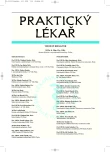Guillain-Barré syndrome. Specific features of intensive care, potential for therapeutic use of plasmapheresis, and our experience
Authors:
R. Zazula; T. Řezáč; J. Cihlář
Authors‘ workplace:
Přednosta: MUDr. Roman Zazula Ph. D.
; Anesteziologicko-resuscitační klinika 1. LF UK a FTNsP, Praha
Published in:
Prakt. Lék. 2008; 88(10): 582-588
Category:
Of different specialties
Overview
Guillain-Barré syndrome (GBS) is a group of autoimmune diseases consisting of demyelinization forms and axonal degenerative forms. The individual subtypes can be distinguished using electrophysiological investigation, particularly by conduction studies. The disease is usually preceded by infection by some known pathogen triggering an autoimmune-based cross-reaction affecting peripheral nerve tissue. The patient develops symmetrical muscular weakness persisting for some time, with subsequent progressive improvement of the condition, usually with complete recovery without any sequels. The risk of death with the severe forms is associated primarily with dysautonomy and respiratory failure requiring mechanical lung ventilation. It is particularly these most severe cases which require comprehensive intensive care. Management involves specific immunomodulatory therapy with therapeutic plasmapheresis or intravenous immunoglobulin administration, combined with supportive therapy including mechanical lung ventilation, required by about one in ten patients. The review includes our own experience with the management of severe GBS in the authors’ department.
Key words:
Guillain-Barré syndrome, mechanical lung ventilation, plasmapheresis, intravenous immunoglobulin.
Sources
1. Alshleklee, A., Hussain, Z., Sultan, B., Katirji, B. Guillain-Barré syndrome: Incidence and mortality rates in US hospitals. Neurology 2008, 70, p. 1608-1613.
2. Ambler, Z. Akutní polyneuropatie. Čes. a slov. Neurol. Neurochir. 2006, 69/102, 1, s. 4-16.
3. Asbury, A.K., Cornblath, D.R. Assessment of current diagnostic criteria for the diagnosis of Guillain-Barré syndrome. Ann. neurol. 1990, 27 (suppl), p. 21-24.
4. Bednařík, J. Zánětlivé polyneuropatie. Neurologie pro praxi, 2001, 3, s. 115-121.
5. van Doorn, PA. Treatment of Guillain-Barré syndrome and CIDP. J. Peripher. Nerv. Syst, 2005, 10, p. 113-127.
6. Farkkila, M., Kinnlinen, E. The Guillain-Barré syndrome study group : Plasmapheresis and acute Guillain-Barré syndrome, Neurology 1985, 35, p. 1096-1104.
7. French cooperative group on plasma exchange in Guillain-barré syndrome. Appropriate numer of plasma Exchange in Guillain-Barré syndrome. Ann. neurol. 1997, 41, p. 298-306
8. Goetz, C.G. Textbook of clinical neurology, 3rd ed. Philadelphia: Saunders, an imprint of Elsevier Inc. 2008. ISBN-13: 978-1-4160-3618-0.
9. Hiraga, A., Mori, M., Ogawara, MD. Differences in patterns of progresion in demyelinating and axonal Guillain-Barré syndromes, Neurology 2003, 61, p. 471-474.
10. Hughes, RA. Randomised trial of plasma exchange, intravenous immunoglobulin, and combined treatments in Guillain-Barré syndrome. Plasma exchange / sandoglobulin Guillain-Barré trial group. Lancet 1997, 349, p. 225-230.
11. Hughes, R.A., van der Meche, F.G.A. Corticosteroids for treating Guillain-Barré syndrome. Cochrane Database Syst. Rev. 2003 (4), CD001446.
12. Hughes, R.A., Raphaël, J.C., Swan, A.V., van Doorn, PA. Intravenous immunoglobulin for Guillain-Barré syndrome, Cochrane database syst. rev. 2004 (1), CD002063.
13. Hughes, R.A., Wijdicks, E.F., Barohn, R. et al. Practice parameter: immunoterapy for Guillain-Barré syndrome: report of the quality standarts subcomitee of the American Academy of neurology. Neurology, 2003, 61, p. 736-740.
14. Joseph, S.A., Teak, Ch.Y. Guillain-Barré syndrome. Adolescent med. 2002, 13(3), p. 487-494.
15. van Koningsveld, R., Steyerberg, E.W., Hughes, R.A. et al. A clinical scoring system for Guillain-Barré syndrome. The Lancet neurology 2007, 6(7), p. 589-594.
16. Lewis, R.A. Guillain-Barré syndrome. In: Kruse, J. Saunders manual of critical care. 1st ed. Philadelphia: Saunders, an imprint of Elsevier Inc., 2003.
17. Lindenbaum. Y., Kissel, J., Mendell, J.R. Treatment aproaches for Guillain-Barré syndrome and chronic inflammatory demyelinating polyradiculopathy. Neurologic clinic 2001, 19(1), p. 187–204.
18. Madore, F. Plasmapheresis – technical aspects and indications. Critical care clinics 2002, 18(2), p. 375-392.
19. Maramottom, B.V., Wijdicks, E.F., Dellinger, R.P. Acute neuromuscular weakness in the intensive care unit. Critical care medicine 2006, 34(11), p. 2835-2841.
20. McGillicuddy, D.C., Walker, O., Shapiro, N.I., Edlow, J.A. Guillain-Barré syndrome in the emergency department, Annals of emergency medicine 2006, 47(4), p. 390-393.
21. van der Meche, F.G., Schmitz, P.I. Dutch Guillain-Barré study group: A randomised trial comparing intravenous immune globulin and plasma exchange in Guillain-Barré syndrome. N. Engl. J. Med.1992, 326, p. 1123-1129.
22. Newswanger, D.L., Warren, C.R. Guillain-Barré syndrome. American fam. physician, 2004, 69(10), p. 2405-2410.
23. Ropper, A.H. The Guillain-Barré syndrome. N. Engl. J. Med. 1992, 326, p. 1130-1136.
Labels
General practitioner for children and adolescents General practitioner for adultsArticle was published in
General Practitioner

2008 Issue 10
Most read in this issue
- Guillain-Barré syndrome. Specific features of intensive care, potential for therapeutic use of plasmapheresis, and our experience
- Common basic classifications of child fractures
- Mentalization
- Uncommon nasopharyngeal tumor in old age - nasopharyngeal angiofibroma?
